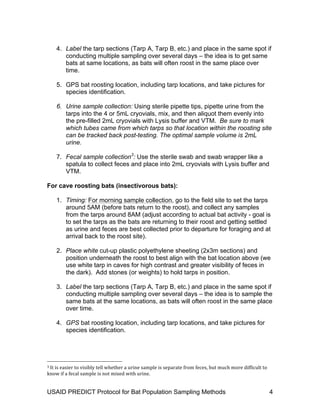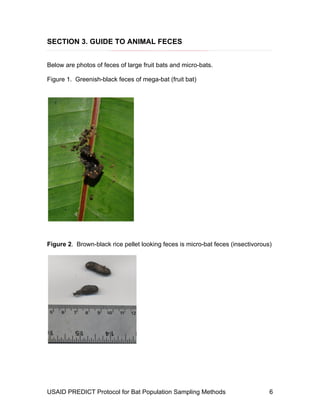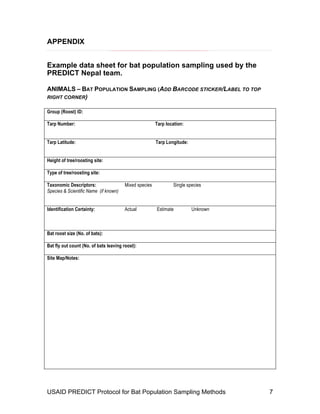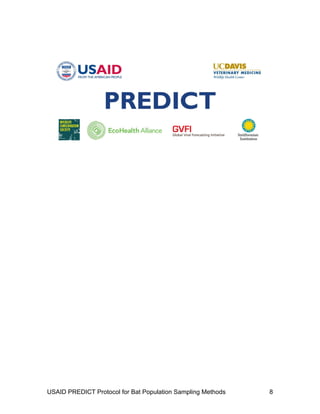This document provides a protocol for safely collecting pooled biological samples from wild bat roosting sites in 3 sentences:
It outlines supplies needed, methods for placing tarps under tree-roosting and cave-dwelling bat colonies to collect urine and feces samples before the bats leave at dawn, and guidance for collecting and recording the samples while minimizing risks to field workers. Examples of bat feces are also provided to help with identification and differentiation from other animal waste.
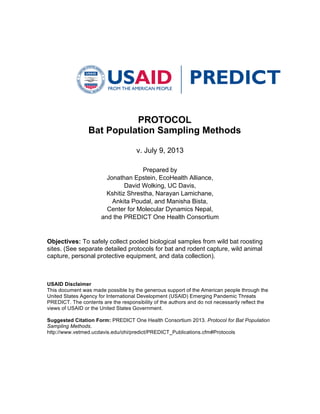
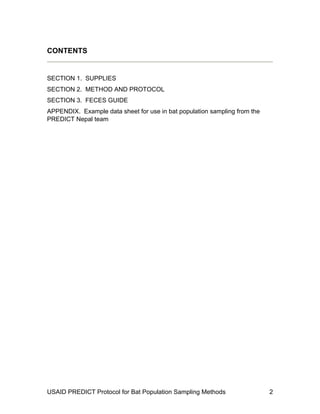
![USAID PREDICT Protocol for Bat Population Sampling Methods 3
SECTION 1. SUPPLIES
1. Polyethylene sheets (long sheets of clear plastic for non-cave bats, white
plastic for cave dwelling bats for better contrast) - often available locally,
can also purchase rolls.
2. Stones (or weights to hold tarp corners down)
3. Pipette
4. Sterile pipette tips to pool urine
5. Sterile polyester swabs with plastic shafts
6. Cryo-safe vials or tubes [larger cryovials (4-5mL that combined can hold
up to 750mL for pooled urine]: we will be using 5-6 tubes/plastic sheets.
7. Cryo-safe vials (up to 2mL) to hold actual samples for testing.
8. LN2 dryshipper
9. PPE [Hats, nitrile gloves (2 pair at a time), respirator, goggles]
SECTION 2. METHOD AND PROTOCOL
For tree roosting bats (fruit bats):
1. Reconnaissance: observe the bat roost and conduct a count during the
day and a flyout count (count bats as they leave the roost at sunset) the
evening of sampling to obtain an estimate of roost size. Record a GPS
location of the roost. If more than one tree, record the approximate size of
the roost and track the length of the roost using GPS.
2. Timing: For morning sample collection, go to the field site to set the tarps
around 4AM (before bats return to the roost), and collect any samples
from the tarps around 6AM (adjust according to actual bat activity1
- goal is
to set the tarps as the bats are returning to their roost and getting settled
as urine and feces are best collected prior to departure for foraging and at
arrival back to the roost site). This timing will also help maximize bat
excrement collection and minimize bird excreta collection.
3. Placing traps: Place cut up plastic polyethylene sheeting2
(2x3m sections)
and position underneath the roost to best align with the bat location above
(either linearly if aligned linearly in trees, or more blocked - depends on
bat tree roosting positions. Add stones (or weights) to hold tarp in
position.
1
Behavior
may
vary
regionally
and
with
species.
A
night
of
observation
may
be
required
to
assess
the
timing
of
return.
In
some
cases,
bats
may
return
earlier
in
the
night,
in
which
case
tarps
could
be
laid
at
2AM
and
samples
collected
between
5-‐6
AM
once
the
majority
of
bats
are
back.
2
If
reusing
sheets,
rinse
them
with
water
and
allow
to
dry
in
the
sun
to
disinfect
before
next
use,
or,
use
new
sheets
for
each
sampling
event.](https://image.slidesharecdn.com/0ee6b02f-7785-4fb5-ba38-711f0e27b776-150924023344-lva1-app6891/85/PROTOCOL-Bat-sampling-method-3-320.jpg)
